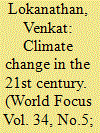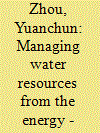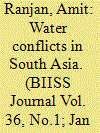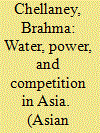| Srl | Item |
| 1 |
ID:
120945


|
|
|
| 2 |
ID:
163555


|
|
|
|
|
| Summary/Abstract |
As one of the most developed provinces in China, Jiangsu province is facing both energy and water stresses. The impact of energy production on water resource remains to be seen, especially in terms of a changing climate. In this study, we adopt a Long-range Energy Alternatives Planning System (LEAP) model combined with plant-level data to study the impact of energy policies on water resources management. The results indicate that energy efficiency improvements and industry structure optimization can result in 40% and 33% water withdrawal savings respectively in the future depending on the level of optimization. With several integrated measures, total water use can meet the 2030 targets set by the Jiangsu provincial government. Shifts in cooling technology can bring significant water-savings benefits and help fulfill water use-control targets. Furthermore, we find that the Suzhou and Xuzhou administrative areas will experience power output efficiency reductions and will need more water in 2030 under the RCP45 and RCP85 scenarios. More efforts are needed to mitigate climate change and offset its negative impact on energy and water resource. The results of this study will be informative for both resource management and policy design.
|
|
|
|
|
|
|
|
|
|
|
|
|
|
|
|
| 3 |
ID:
140305


|
|
|
|
|
| Summary/Abstract |
Water conflict in South Asia is one of the critical challenges for the region. The unitary irrigation system constructed since Mughal period was divided in 1947, when the sub-continent was partitioned into India and Pakistan. Not enthusiastic to break the then existing hydrological, railway and port systems, Sir Cyril Radcliffe took ‘other factors’ also into consideration and not only religion as a sole determinant to partition the sub-continent. Despite his efforts, the water bodies were divided between the two arch enemies. Soon after the partition, the conflicts over shared water bodies started and have been graduated over the decades. The political animosities among the South Asian neighbours have inflamed the water conflicts further. As a result, arrangements, agreements and treaties seeking cooperation over shared water resources have failed to address water related grievances of each country. One common allegation the neighbouring countries have is that India exploits their resources for its own use. This allegation helps the radical elements from those countries to espouse the causes and raise the cries of water nationalism. Not only in those countries, the feeling of ‘sovereign’ rivers is also strong in India. The political tensions over water are duly aided by the growing supply-demand gap, phenomenon of climate change and predominant use of supply-side management system. Though the water conflicts are bilateral, it has regional implications. Realising this fact, in most of the regions, the regional organisations have taken steps to mitigate differences among the riparian states and have helped them to enter into a cooperative arrangement. In South Asia, this is difficult to attain because the South Asia Association for Regional Cooperation (SAARC) is not a very effective body.
|
|
|
|
|
|
|
|
|
|
|
|
|
|
|
|
| 4 |
ID:
133765


|
|
|
|
|
| Publication |
2014.
|
| Summary/Abstract |
At a time when Asia is at a defining moment in its history, water stress has emerged as one of its most serious challenges. Water shortages have not only stirred geopolitical tensions by intensifying competition over the resources of shared rivers and aquifers, but they also threaten Asia's continued economic rise.
|
|
|
|
|
|
|
|
|
|
|
|
|
|
|
|